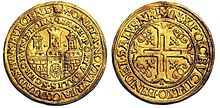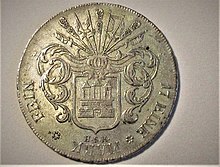Hamburg Mint
|
Hamburg Mint |
|
|---|---|
| State level | Free and Hanseatic City of Hamburg |
| position | State company / mint |
| Supervisory authority | Hamburg Finance Authority (Asset and Investment Management - Department 31) |
| founding | 834 |
| Headquarters | Hamburg, at the New Mint 19 |
| Authority management | Ralph Thiemann, coin manager |
| Servants | 45 |
| Web presence | www.muenzehamburg.de |
The Hamburg Mint ( also Hamburg Mint ) is the oldest German mint . It has a “J” as a mintmark and, as a state company, is subject to the tax authorities of the Free and Hanseatic City of Hamburg .
45 permanent employees work in the mint. The coin manager is Ralph Thiemann .
The Hamburg Mint produces some of the German coins in circulation (21 percent) and commemorative coins of the Federal Republic of Germany as well as foreign coins as well as commemorative coins without face value ( medals ) and mints of special historical coins such as B. the 1 billion mark piece from the province of Westphalia .
In contrast to the four other mints in Germany , the Hamburg mint is not accessible to private groups of visitors.
history
In the year 834 coins were struck in Hamburg for the first time. The right to mint , granted by the Emperor, was held by the Archbishop of Hammaburg . In 1189, Emperor Friedrich Barbarossa granted the Hamburg Mint the right to examine the Graeflich Schauenburg mint. The Counts of Holstein sold the mint to the city of Hamburg, which allowed them to strike their own coins. Most of the coins were bracteates . After Hamburg was in possession of the right to mint in 1325, the city minted the so-called Eternal Pfennig , which was no longer subject to the annual revocation of coins , as was previously the case with the bracteates of the Counts of Holstein.
In 1435, the Hamburg Mint was granted the right to mint gold coins, the guilders , by Emperor Sigismund . In 1553, thalers and Portuguese were first minted in the mint .
After French troops occupied the city in 1806, operations of the mint were suspended in 1813. The previous mint master HS Knoph acquired part of the equipment and operated a private coin on behalf of the Hamburgische Bank , in which he produced Hamburg ducats and coins .
In 1842 this mint was destroyed by the Hamburg fire . Until the new mint was established, the mints of the neighboring Royal Mint in Altona , Hanover and Berlin supplied Hamburg with coins. It was not until 1873 that the Hamburg citizenship decided to build a new mint, which was opened on Norderstraße in 1875 and has had the "J" since then. Hamburg became the ninth mint of the German Empire and was therefore assigned the ninth letter of the alphabet as a mint mark (“I” was used as “J”). The eight embossing machines used came from the Strasbourg mint and had been in operation there since 1851 and 1852.
The Hamburg Mint was badly damaged in the Second World War , so that it could not start operating again until 1948. In 1982 - after four years of construction - the move to a new building, a functional building "An der Neue Münze" in an industrial area in Hamburg-Rahlstedt .
Euro coins
The euro and cent coins in circulation are minted in all German mints. In contrast, the 10 euro commemorative coins are only minted in one mint.
Web links
- Official website
- Portrait of the Hamburg Mint in the German Coins Magazine (PDF file; 346 kB)
literature
- 650 Years of Hamburg's Minting - A Festschrift - published by the Hamburg Mint, 1975
Individual evidence
- ^ Gert Hatz: Foray through the Hamburg coin history; in 650 years of Hamburg coinage, p. 10 ff.
- ^ Friedrich von Schrötter, N. Bauer, K. Regling, A. Suhle, R. Vasmer , J. Wilcke: Dictionary der Münzkunde , Berlin 1970 (reprint of the original edition from 1930) p. 440
- ^ Hubertus von Wegerer: Hundred Years of the Hamburg Mint on Norderstrasse; in: 650 years of Hamburg coinage, p. 22ff
- ^ Clas Abels: 100 years of coin operation in Norderstrasse ; in: 650 years of Hamburg coinage , p. 29 ff
- ↑ Steffen Preissler: The 20 euro coin from Rahlstedt. In: Hamburger Abendblatt, May 12, 2012, p. 27
Coordinates: 53 ° 37 ′ 27.9 ″ N , 10 ° 9 ′ 13.6 ″ E





